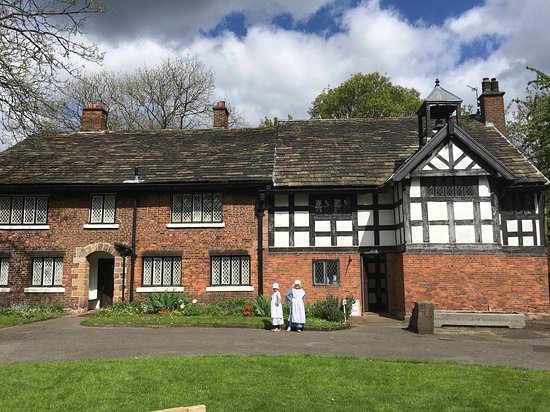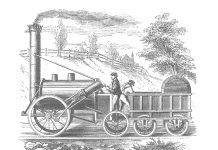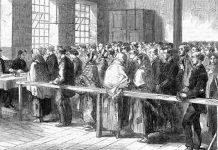In our latest on the great and the good and the stories of Greater Manchester. we trace a famous family whose origins go back to William the Conqueror and whose leagcy remains in a part of East Manchester
You might be forgiven for not noticing a Grade II listed building hidden amongst the trees and surrounded by houses just off the Ashton New Road.
The only moated building to survive in the Manchester area, dates from the 12th century.
It was once the family seat of the Byron’s and latterly of Humphrey Chetham, rebuilt, saved from demolition and now opened as a Victorian living history museum.
Under its original owners the Clayton’s the hall illuminated this land,three miles east of Manchester during the 12th century,but the lands soon passed to the Byron dynasty as Sir Roger de Buron married Cecilia ,daughter and heiress of Sir John Clayton.
The Byrons could trace themselves back to the time of the conqueror when Hugh de Buron is mentioned in the Domesday book as owning lands in Nottinghamshire and Derbyshire.
He may well have journeyed with William the Conqueror across the Channel having originated in the Normandy village of Beuron.
The tentacles of the Byron family spread across Manchester for the next 700 years even today the University has a Byron centre dedicated to the life, writings, times, worldwide reception and international influence of the nineteenth century poet, a distant relation of Hugh de Burun and the John Rylands library on Deansgate has a substantial repository of his legacy.
Their ancestral home was not however in Manchester but in Nottinghamshire where they added the larger estates of the Colwicks to their Lancashire holdings.
By the 1400’s the family had made Colwick its chief residence,later under Sir John Bryron, purchasing Newstead Abbey for the sum of £810 from Henry the eighth after Cromwell had expelled the monks in 1539.
Sir John was the first Byron since his distant ancestor from Normandy to play a large role in England’s political life,though earlier an earlier descendent had fought on the side of Henry Tudor at the battle of Bosworth
For at least part of this time he was living at Royton Hall,much of the district had come into the families hands in the 13th century and was to remain so until the 17th.
Sir John was very much caught up in the intrigues of Henry’s court.Having supplied men for the kings arm,he himself served overseas.
By 1519, when he received the first of several offices in Nottinghamshire and in the administration of Sherwood, he was an esquire of the body, and he had been knighted by November 1522 when he was first nominated sheriff of Nottinghamshire.
Active in the administration of his shire, he retained his place at court throughout the reign of Henry VIII and was a servitor at the coronation of Anne Boleyn and one of those who received Anne of Cleves at Blackheath in 1540.
When the North rose against the king in 1536,he accompanied the Earl of Shrewsbury into Yorkshire and later acted as juror for the trial of several of the rebels at Westminster.
He saw further military service against the Scots in 1542 when he equipped himself with 20 servants ‘to serve the King’s grace horsed and harnessed’, and was evidently responsible for levying a considerable body of men from Nottinghamshire.
He was appointed from the shire to fight under the King in France in 1544, and 13 years later he was one of the local gentry responsible for levying 300 men for the defence of Berwick. He was also active in the King’s service as a commissioner for the dissolution of the monasteries in the north.
After witnessing the draft submission of the abbot of Furness in April 1537, he was sent to take over the abbey, with Sir Thomas Butler and Sir Richard Houghton, to prevent embezzlement. In the same year he helped in the removal of the roof of Cartmel priory.
He was a trustee of Manchester grammar school, held stewardships in Manchester and Rochdale and bought and leased land in this area.In 1550, he obtained from Cranmer a 21-year lease of the Rochdale tithes at a rent of £80.
He died on 5 May 1567 but very strangely had made his will eight years earlier in which he profoundly expressed his Catholic faith,confounding those who had seem his role in the reformation.
His will was proved on 31 May and on 1 October his death was recorded by the jury of Manchester court, who stated that ‘John Byron esquire is … his son and heir and owes suit and service to this court and pays certain chief rents according as it has been accustomed’. Byron’s widow survived him by several years and was buried at the collegiate church in Manchester in 1580.
The Byron’s sold Clayton hall to a couple of London merchants,George and Humphrey Chetham,the later would go on to found the famous school in the centre of the town and we will save that story for another day.








Will have to pay Clayton hall a visit as I’m. Local to it. I use to work at st cross next to it in the 80s. When on a visit to Salford museum a few years ago I met a lady that said she opening it up as a museum so would be nice to meet her again. I’m a member of the .NCMD. The National council metal detecting and have donated some of my finds to museums so maybe an opportunity to ask if they would like the grounds detected and the finds donated to the museum.